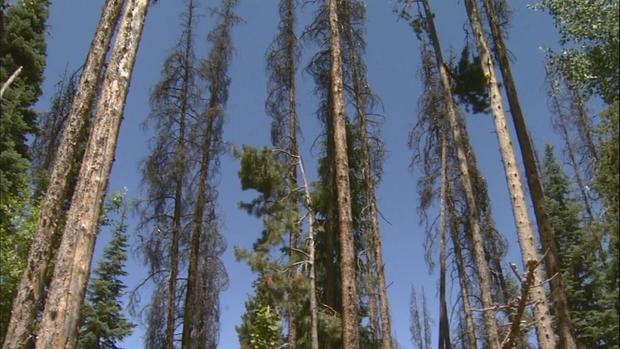Colorado Has 834 Million Dead Trees, Fires Could Get Worse
DENVER (AP) - Colorado's beetle-infested forests are peppered with an estimated 834 million standing dead trees that threaten to worsen wildfires and degrade vital water supplies that flow from mountains, officials said Wednesday.
Roughly one in every 14 standing trees in the state's forests is dead, with the total up 30 percent in seven years, the State Forest Service said in its annual report on forest health.
"Is it something to be alarmed about? Of course it is," State Forester Mike Lester said. "When they have this condition, you should be paying attention to it."
Infestations of mountain pine beetles and spruce beetles are the main cause of the die-off, Lester said. Beetles are native to the state but have caused far more damage than normal over the past 20 years, attacking more than 7,900 square miles of forest, or more than 20 percent of total forested land.
Lester and others blame the beetle outbreak on a combination of warmer weather that allows beetles to survive the winter and trees left more vulnerable because of age and stress from severe droughts in the past.
Although the pine beetle epidemic has subsided, spruce beetles are still spreading. The course of that outbreak will determine whether the tree die-off worsens or levels off, Lester said.
"I really couldn't predict," he said. "We're not sure where the spruce beetle is going to go right now."
A combination of standing and fallen trees killed by beetles can make wildfires burn longer and in some cases hotter, the report said, making them harder and more expensive to control and putting firefighters in more danger.
A fire last year among dead trees in northwestern Colorado and southern Wyoming that burned for about four months on nearly 60 square miles could foreshadow what firefighters will face in the future, the report said.
Wildfires, in turn, threaten to worsen erosion by killing trees that help keep soil in place on hillsides, the report said. Erosion can load rain and melting snow with silt, change the timing of that spring runoff and reduce the capacity of reservoirs when the sediment settles to the bottom, the report said.
Those effects can disrupt water supplies for cities and agriculture in Colorado and beyond. An extensive system of reservoirs, canals and pipelines depends on a massive inflow of water every spring from melting snow.
The Colorado Water Conservation Board estimates that 80 percent of the state's population relies on runoff from forested watersheds, and 19 states and Mexico get water from Colorado's mountain snows.
Among other steps, the state is working with federal and local governments and with private landowners to thin out forests that are too dense and fire-prone and to replant hillsides stripped bare by fires.
Dead trees also are a threat in California, where the U.S. Forest Service says drought has killed more than 102 million trees.
Wildfire Resources
- Visit CBSDenver.com's Living With Wildfire section.
Wildfire Photo Galleries
- See images from the most destructive wildfires (Black Forest, Waldo Canyon, High Park and Fourmile) and largest wildfire (Hayman) in Colorado history.
- By DAN ELLIOTT, AP Writer
(© Copyright 2017 The Associated Press. All Rights Reserved. This material may not be published, broadcast, rewritten or redistributed.)




